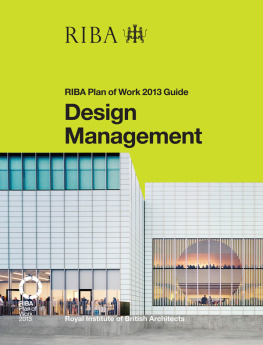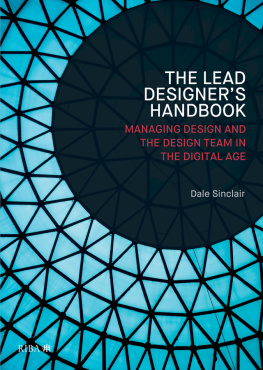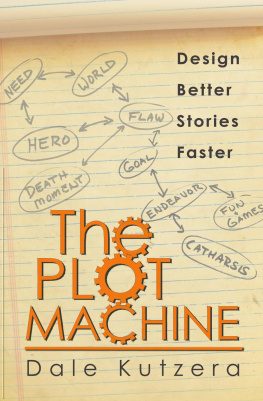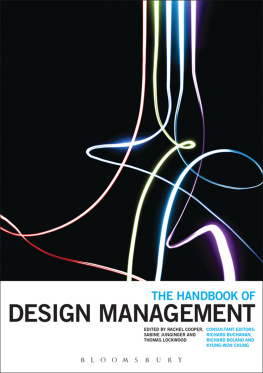Dale Sinclair - Design Management
Here you can read online Dale Sinclair - Design Management full text of the book (entire story) in english for free. Download pdf and epub, get meaning, cover and reviews about this ebook. year: 2019, publisher: RIBA Publishing, genre: Romance novel. Description of the work, (preface) as well as reviews are available. Best literature library LitArk.com created for fans of good reading and offers a wide selection of genres:
Romance novel
Science fiction
Adventure
Detective
Science
History
Home and family
Prose
Art
Politics
Computer
Non-fiction
Religion
Business
Children
Humor
Choose a favorite category and find really read worthwhile books. Enjoy immersion in the world of imagination, feel the emotions of the characters or learn something new for yourself, make an fascinating discovery.
- Book:Design Management
- Author:
- Publisher:RIBA Publishing
- Genre:
- Year:2019
- Rating:5 / 5
- Favourites:Add to favourites
- Your mark:
- 100
- 1
- 2
- 3
- 4
- 5
Design Management: summary, description and annotation
We offer to read an annotation, description, summary or preface (depends on what the author of the book "Design Management" wrote himself). If you haven't found the necessary information about the book — write in the comments, we will try to find it.
Design Management — read online for free the complete book (whole text) full work
Below is the text of the book, divided by pages. System saving the place of the last page read, allows you to conveniently read the book "Design Management" online for free, without having to search again every time where you left off. Put a bookmark, and you can go to the page where you finished reading at any time.
Font size:
Interval:
Bookmark:

Design Management
The RIBA Plan of Work 2013 Guides
Other titles in the series:
Project Leadership, by Nick Willars
Contract Administration, by Ian Davies
Town Planning, by Ruth Reed
Coming in 2015:
Information Exchanges
Sustainability
Conservation
Health and Safety
Handover Strategy

RIBA Enterprises Ltd, 2014
Published by RIBA Publishing, The Old Post Office, St Nicholas Street, Newcastle upon Tyne NE1 1RH
ISBN 978 1 85946 550 9
Stock code 82650
The right of Dale Sinclair to be identified as the Author of this Work has been asserted in accordance with the Copyright, Designs and Patents Act 1988 sections 77 and 78.
All rights reserved. No part of this publication may be reproduced, stored in a retrieval system, or transmitted, in any form or by any means, electronic, mechanical, photocopying, recording or otherwise, without prior permission of the copyright owner.
British Library Cataloguing in Publication Data
A catalogue record for this book is available from the British Library.
Commissioning Editor: Sarah Busby
Series Editor: Dale Sinclair
Project Manager: Alasdair Deas
Design: Kneath Associates
Typesetting: Academic+Technical, Bristol, UK
Printed and bound by CPI Group (UK) Ltd
Cover image: Simon Menges, Turner Contemporary
While every effort has been made to check the accuracy and quality of the information given in this publication, neither the Author nor the Publisher accept any responsibility for the subsequent use of this information, for any errors or omissions that it may contain, or for any misunderstandings arising from it.
RIBA Publishing is part of RIBA Enterprises Ltd
www.ribaenterprises.com
This Design Management Guide is a timely publication, coming as it does at a point when the time pressures on the design process are so intense. In the pre-construction period, the design process is increasingly compacted into a shorter period as the wish to get on to site earlier with a high degree of cost certainty increases. There is then the conflicting requirement to manage design input that is prepared over an increasingly longer portion of the overall construction process in particular, that undertaken by contactors and their specialist subcontractors generally simultaneously with the construction period. In such a pressured environment it is welcome to see a renewed focus on the role of the lead designer and the skills and tools needed in managing the production, coordination and integration of the design into the overall project.
In this context the comprehensive rethinking undertaken by the authors of the RIBA Plan of Work 2013 has brought a breadth and depth of clarity. Its focus on the flexibility needed to address different procurement routes, the emphasis on the collaborative nature of design and the integrated consideration of sustainability and digital design environments is resulting in a positive adoption across the industry. This guide, one of a suite supporting the RIBA Plan of Work 2013, now provides a valuable stage-by-stage route map to those undertaking the lead designer role.
In practice, of course, the design process rarely proceeds according to the strictly linear and ideal manner sometimes suggested by management guides; the reality is more often confused, exciting and dynamic, charged by conflicting commercial interests and coloured by the personalities involved.
Within this arena, the lead designer, armed with the guidance and the tools set out in this guide, and bolstered by their own strength of will and force of personality, will be better able to bring clarity of direction to and communication between the design team for the benefit of the project.
Whether for some, as the author says, design begins with a blank computer screen or for others with an empty stretch of sketch roll and a pen, adequate time needs to be allowed at the earliest stages for the right design to develop if a robust strategy and clear direction are to be established for the project.
A strong lead designer has a key part to play in creating that time for design and, with the understanding that management is not an end in itself, but that designers are usually best placed to manage design, this renewed focus on the role can only be positive for the design professions.
Jonathan Hall
Director and Co-founder, Allford Hall Monaghan Morris
The RIBA Plan of Work 2013 was developed in response to the needs of an industry adjusting to emerging digital design processes, disruptive technologies and new procurement models, as well as other drivers. A core challenge is to communicate the thinking behind the new RIBA Plan in greater detail. This process is made more complex because the RIBA Plan of Work has existed for 50 years and is embodied within the psyche and working practices of everyone involved in the built environment sector. Its simplicity has allowed it to be interpreted and used in many ways, underpinning the need to explain the content of the Plans first significant edit. By relating the Plan to a number of commonly encountered topics, the RIBA Plan of Work 2013 Guides series forms a core element of the communication strategy and I am delighted to be acting as the series editor.
The first strategic shift in the RIBA Plan of Work 2013 was to acknowledge a change from the tasks of the design team to those of the project team: the client, design team and contractor. are part of this shift, acknowledging that buildings are used by clients, or their clients, and, more importantly, recognising the paradigm shift from designing for construction towards the use of high-quality design information to help facilitate better whole-life outcomes.
New procurement strategies focused around assembling the right project team are the beginnings of significant adjustments in the way that buildings will be briefed, designed, constructed, operated and used. Design teams are harnessing new digital design technologies (commonly bundled under the BIM wrapper), linking geometric information to new engineering analysis software to create a generation of buildings that would not previously have been possible. At the same time, coordination processes and environmental credentials are being improved. A core focus is the progressive fixity of high-quality information for the first time, the right information at the right time, clearly defining who does what, when.
The RIBA Plan of Work 2013 aims to raise the knowledge bar on many subjects, including sustainability, Information Exchanges and health and safety. The RIBA Plan of Work 2013 Guides are crucial tools in disseminating and explaining how these themes are fully addressed and how the new Plan can be harnessed to achieve the new goals and objectives of our clients.
Dale Sinclair
November 2014
I would like to thank Adrian Dobson, RIBA Director of Practice, who was instrumental in kick-starting the development of the RIBA Plan of Work 2013, as well as the many architects who contributed to the development of the Plan. I would also like to thank the members of the various CIC groups who helped define the new project stages that are now integrated into the Plan.
This guide would not have been possible without the practical project experience I gained while working at BDP and Dyer and I would like to thank the directors of these companies and the many clients and design team collaborators who have provided their insights and contributions over the years.
Font size:
Interval:
Bookmark:
Similar books «Design Management»
Look at similar books to Design Management. We have selected literature similar in name and meaning in the hope of providing readers with more options to find new, interesting, not yet read works.
Discussion, reviews of the book Design Management and just readers' own opinions. Leave your comments, write what you think about the work, its meaning or the main characters. Specify what exactly you liked and what you didn't like, and why you think so.













